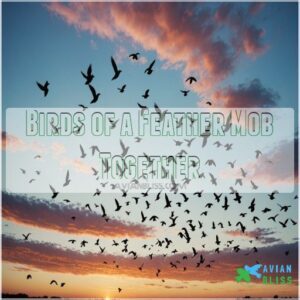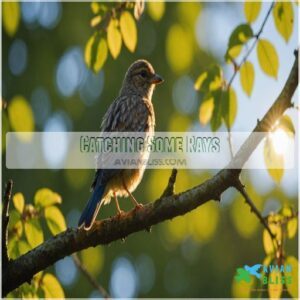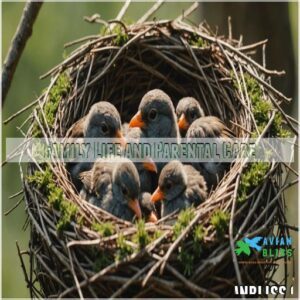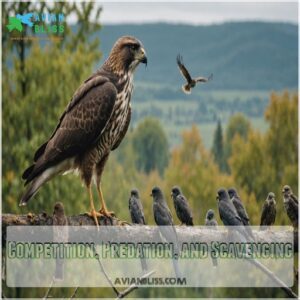This site is supported by our readers. We may earn a commission, at no cost to you, if you purchase through links.
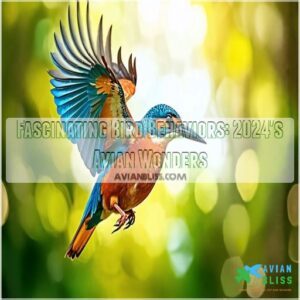
Ever seen a mob of tiny Blue-gray Gnatcatchers bravely harass a formidable Red-tailed Hawk? That’s mobbing in action, a bold defense strategy.
Or take a closer look at herons catching rays with their delta-wing posture while they sunbathe—it’s like their version of a spa day, helping with temperature regulation and pesky parasites.
Then there’s the wily skua, a master thief, swiping food from unwary penguins.
And let’s not forget the caracaras, social and smart, adept at finding a meal and a friend.
Each of these avian wonders offers unique insights that will have you looking up in awe.
Table Of Contents
- Key Takeaways
- Birds of a Feather Mob Together
- Catching Some Rays
- Sneaky Skuas and Seaweed Stealers
- Caracaras and Their Unique Behaviors
- Family Life and Parental Care
- Competition, Predation, and Scavenging
- Growth and Development
- Birds of Stunning Beauty and Mimicry
- Majestic Soaring Hunters
- Avian Wonders and Unique Behaviors
- Frequently Asked Questions (FAQs)
- What is bird behavior?
- How do I learn about bird behavior?
- Why is birdwatching important?
- How do I learn to think like a bird?
- What are the unique abilities of birds?
- What traits are unique to birds?
- What are some unique things birds can do?
- What are the intelligent behavior of birds?
- How do birds migrate long distances?
- What is the purpose of bird song?
- How do birds build their nests?
- Why do some birds have bright colors?
- How do birds survive harsh winters?
- Conclusion
Key Takeaways
- You’ll be amazed by bird behaviors like mobbing, where tiny gnatcatchers bravely team up to scare off large predators.
- Birds like herons sunbathe in unique postures to regulate temperature and fend off parasites, showcasing clever adaptations.
- Skuas and wigeons thrive as opportunistic thieves, highlighting the competitive nature of bird interactions for survival.
- Caracaras form symbiotic relationships with cattle, demonstrating intelligence and social behavior in gaining food and allies.
Birds of a Feather Mob Together
You’d think a pint-sized Blue-gray Gnatcatcher wouldn’t dare take on a Red-tailed Hawk, but these gutsy little birds aren’t afraid to make a scene.
Mobbing, this fascinating communal defense strategy, lets smaller birds like the gnatcatcher successfully pester larger predators, demonstrating that teamwork and a dash of courage can go a long way in the wild.
Blue-gray Gnatcatcher Vs Red-tailed Hawk
Imagine a feisty Blue-gray Gnatcatcher bravely confronting a Red-tailed Hawk, despite their size disparity. Here’s what you might witness:
- The gnatcatcher darts between branches with tenacity.
- Gnatcatcher’s instincts, like those of fiercely territorial birds such as blue jays who exhibit complex breeding season behaviors, kick in to protect its nesting habits.
- The hawk’s reaction to mobbing is strategic retreat.
- This display fascinates anyone curious about avian behavior and bravery.
Mobbing as a Defense Mechanism
Ever watched a storm of birds chase a big predator away?
It’s called mobbing, a clever defense mechanism where smaller birds band together to defend against larger threats.
Mobbing relies on group dynamics, turning the tables in predator-prey scenarios.
It’s a fascinating blend of bird behavior and survival tactics—nature’s own version of “safety in numbers,” using bird communication at its finest.
Examples of Mobbing Behavior
Feisty and fearless, small birds band together against larger foes in displays of mobbing behavior.
Picture a tiny Blue-gray Gnatcatcher harassing a mighty Red-tailed Hawk—it’s fascinating bird behavior at its finest.
Mobbing success relies on:
- Strength in numbers
- Strategic pecking and noise
- Nests and young as triggers
- Learning from past encounters
Mobbing, a brilliant evolution in bird characteristics!
Catching Some Rays
Ever seen a heron striking a dramatic delta-wing pose, as if auditioning for the next big bird fashion show?
Many birds, including herons, sunbathe to soak up some warmth, potentially regulating their body temperatures and giving any lingering parasites the boot.
Herons and Their Delta-Wing Posture
When herons spread their wings in a delta-wing posture, you might wonder what’s going on.
This posture helps with heron thermoregulation and parasite control, showing off their fascinating bird adaptations.
Think of it as a sun salutation in the avian world.
Here’s a glimpse into their world:
| Benefit | Behavior | Adaptation |
|---|---|---|
| Thermoregulation | Delta-wing | Cooling effect |
| Parasite Control | Sun exposure | Wing mechanics |
| Relaxation | Posture holding | Bird traits |
Sunbathing in Birds
Think of it as their avian spa day.
They carefully position themselves to maximize sun angles, basking for the best feather health and warmth.
Species like herons even strike a "delta-wing" pose.
This behavior isn’t just about feeling good; it’s a vital adaptation for survival, especially during colder months.
The time of day influences sunbathing, as birds seek the most beneficial rays.
It’s a fascinating example of animal adaptations and bird evolution in action.
Temperature Regulation and Parasite Control
While you’re amazed by sunbathing birds, think of them catching some rays to tackle heat stress and parasites.
Picture herons with their "delta-wing" pose or owls sunbathing between migrations.
It’s as if they’re indulging in a little feather maintenance spa.
This behavior helps dislodge troublesome parasites and regulate body temperature, much like you’d enjoy a cool breeze on a hot day.
Sneaky Skuas and Seaweed Stealers
You’re about to discover how skuas become the crafty bandits of penguin colonies, swooping in to snatch unguarded eggs or chicks while their parents briefly turn their backs.
Meanwhile, American Wigeons have mastered the art of thievery, hanging around diving ducks like coots and cheekily snatching their hard-earned meals with a deftness that would make any trickster proud.
Skuas as Predators of Penguins
Even when penguins waddle across land, skuas swoop in, eyeing an easy meal.
Notably, penguins aren’t the only flightless birds, with birds like the Common Murre resembling young penguins often mistaken for them due to their similar appearance.
So, what makes these interactions fascinating? Let’s see:
- Vulnerability on Land: Penguins, clumsy on terra firma, make irresistible targets.
- Skuas’ Hunting Skill: Adapted to exploit such weaknesses, they snatch eggs, even chicks.
- Defense Tactics: Penguins rally together, their sheer numbers deterring skuas.
Isn’t nature’s balance intriguing?
Skuas’ Scavenging Behavior
Ever seen a Skua snatch food from under a penguin’s nose?
These cunning birds thrive on scavenging as much as hunting.
In the Antarctic ecosystem, they’re adept at exploiting every opportunity, from discarded scraps to unattended nests.
Their resourcefulness is a marvel, showing how Skua adaptations make them formidable competitors in the food chain, much to the dismay of their penguin neighbors!
American Wigeons and Their Food-Stealing Tactics
Picture a bustling underwater cafeteria, where American Wigeons thrive by pilfering meals from coots.
This classic bird heist, known as Wigeon-Coot Dynamics, showcases smart, opportunistic feeding.
Wigeons exploit diving duck strategies, snatching food just within reach.
This adaptive behavior reflects food competition and highlights biodiversity.
It’s all part of bird migration patterns that thread wildlife into complex, interconnected ecosystems.
Caracaras and Their Unique Behaviors
When you think of caracaras, picture them as the clever custodians of the animal kingdom, often seen hitching rides on cattle to snack on ticks.
These interactive birds aren’t just pest control experts; their social and intelligent nature, showcased in fascinating symbiotic relationships, highlights their unique roles in the ecosystem.
Yellow-headed Caracaras and Their Tick-Picking Habits
Speaking of clever bird strategies, let’s look at yellow-headed caracaras.
These birds have a unique relationship with cattle.
You’ll find them perched on cows, expertly picking off ticks.
It’s a win-win!
- The caracaras get a tasty meal.
- The cattle get pest control.
- It’s a perfect example of a Caracara-cattle bond.
Isn’t nature amazing?
Symbiotic Relationships in Nature
Symbiosis in nature is like a well-choreographed dance, where each partner knows their role.
You might notice how Yellow-headed Caracaras join this dance by picking ticks off cattle, much like cleaner fish tidying up larger marine animals.
This mutual aid isn’t just smart; it’s an essential ecological thread.
Without it, balance teeters, reminding us nature’s partnerships make survival a team effort.
Caracaras’ Intelligent and Social Nature
Caracaras, boasting an ingenious side, exhibit remarkable social behaviors, rivaling those of the clever Kea.
Imagine a Caracara leading a group, orchestrating with sharp calls that echo through the wild.
Known for their hunting strategies and social hierarchy, they exemplify survival skills, showcasing problem-solving abilities similar to those of crows and ravens who excel in advanced puzzle-solving techniques.
These intelligent birds hunt with precision but also engage in intricate communication, ensuring their spot in nature’s hierarchy.
Family Life and Parental Care
Among birds, family life can be as entertaining as a reality show, with Crested Caracaras sticking together year-round and Common Potoos camouflaged perfectly during their daily naps.
You’ll find that Barred Owls’ young ones take their sweet time learning to fly, while their diligent parents keep a watchful eye.
Crested Caracaras and Their Parenting Style
You’ve probably wondered how Crested Caracaras manage their family bonds.
These impressive birds display courtship flair with enchanting mating rituals.
Once the chicks hatch, they follow their parents like mini aviators, picking up survival skills along the way.
As communicative caretakers, they foster their chicks’ development, ensuring each feathered newcomer thrives in the selective habitats they’ve chosen—talk about an avian dream team!
Common Potoos and Their Brooding Habits
Ever wondered how Common Potoos keep their cool, mimicking their Great Potoo cousins’ excellent tree bark camouflage?
Imagine this: they spend the day looking like tree bark with their perfect potoo camouflage, only to become master hunters at night.
Both brooding parents take turns with egg incubation, and if you’re lucky, you might spot a potoo yawning mid-nap. It’s a quirky life, indeed!
- Potoo camouflage: blends seamlessly with tree bark
- Nocturnal hunting: targets large flying insects
- Brooding parents: share responsibility
- Quirky yawns: mid-day snooze treats
Barred Owls and Their Nesting Behavior
Barred Owls, with their melodious owl calls, impressively juggle parental care and predator threats.
Owl nestlings, nestled high in trees, rely on vigilant parents selecting safe nest sites.
Red foxes, potential threats, occasionally prowl nearby.
Isn’t it fascinating watching endangered birds fiercely guard their families?
Here’s a quick peek:
| Aspect | Detail | Implication |
|---|---|---|
| Owl Calls | Melodious and clear | Communication |
| Nest Site | High tree cavities | Safety |
| Parental Care | Very attentive | High survival rate |
| Predator Threats | From foxes | Vigilance required |
| Conservation | Protecting habitats | Survival is guaranteed |
Competition, Predation, and Scavenging
Ever wonder how birds grab a bite to eat in a competitive world?
This section explores the thrilling world of avian predation, scavenging, and the constant competition for resources, from sneaky food thieves to fierce predators and opportunistic scavengers.
Bald Eagles and Red Foxes as Predators and Scavengers
Picture the parenting strategies of birds, then shift gears to nature’s dynamic showdown: bald eagles and red foxes showcase survival instincts in the wild.
Their Eagle-Fox Competition is fierce, embodying Prey Preference and Scavenger Tactics.
As both predator and scavenger, they navigate Habitat Overlap.
This performance in Food Chain Dynamics highlights adaptability—a spectacle as thrilling as it’s necessary for survival.
Snowy Sheathbills and Their Scavenging Behavior
Imagine yourself in the icy world of Antarctica, where the Snowy Sheathbill reigns as a master scavenger.
These birds enter penguin colonies, unabashedly snatching krill straight from Gentoo Penguins feeding their chicks.
To get a closer look at these fascinating creatures, grab your bird watching binoculars (Bird Watching Essentials).
It’s a bit like sneaking fries from a friend’s plate—practical and bold.
This behavior reveals their uncanny knack for survival amid fierce competition.
Sheathbills’ Adaptation to Harsh Environments
While sheathbills might seem like the Antarctic’s resident pranksters, these savvy scavengers have adapted to their harsh environment with clever tactics.
With an appetite for anything remotely edible, they’re top contenders in the scavenging success game.
- Thrive on diverse Sheathbill diet
- Employ unique adaptations for Antarctic survival
- Navigate the harsh climate with ease
- Outsmart competitors for food sources
Growth and Development
You’re about to enter the realm of young birds, where watching a Barred Owl clamber up a tree trunk is as thrilling as learning why Wild Turkeys start flying at just two weeks.
Parental care is essential at this stage, and you’ll see how adult birds make sure their little ones successfully navigate the wild.
Young Barred Owls and Their Development
Barred Owls, unlike those cunning scavengers, take their own sweet time developing.
As a young owl, you’ll only start exploring branches at four weeks.
Flight skills? They’re still a dream 10 weeks in!
Your parental roles involve constant food delivery until nest departure.
It’s a slow growth rate, but hey, you can’t rush wisdom—or a perfect flight!
Wild Turkeys and Their Rapid Growth
Wild turkey hatchlings grow at a breakneck pace, taking to the skies within just two weeks. How do they manage such an epic feat? Here’s the scoop:
- Diet – Insects provide protein power.
- Nesting habits – A ground nest means quick takeoff. Providing water sources like bird bath options can also impact their growth and development.
- Escape from turkey predators – Speed is essential for survival.
These quirky relatives of the Thanksgiving bird sure don’t waste time!
Importance of Parental Care in Birds
Think about all the work that goes into raising a family!
From careful nest building to constant chick feeding, parental roles are essential for bird survival.
For example, in bluebirds, both parents work together to provide their hatchlings a protein-rich diet.
Without dedicated parents, fledglings wouldn’t thrive.
Imagine the sibling rivalry!
Parental care guarantees growth and development, ultimately impacting the survival of the species.
It’s a tough job, but someone’s gotta do it!
Birds of Stunning Beauty and Mimicry
When you think of birds that double as nature’s showstoppers, the Resplendent Quetzal, the Lyrebird, and the Atlantic Puffin immediately spring to mind with their striking appearances and playful antics.
These avian wonders embody beauty and mimicry, but they also charm with behaviors such as the Lyrebird’s uncanny sound imitations and the Puffin’s delightful charisma.
The Resplendent Quetzal and Its Emerald Feathers
If bird growth amazes you, wait till you meet the Resplendent Quetzal.
Those emerald feathers aren’t just pretty—they’re steeped in history.
From their ancient symbolism to their role in today’s conservation efforts, these birds fascinate and enchant.
Imagine:
- Vibrant emerald plumage
- Mating rituals with flair
- Illustrious ancient symbolism
- Imperiled habitats due to loss
Understanding them fosters preservation.
The Lyrebird and Its Mimicry Prowess
You might’ve marveled at the Quetzal’s vibrant plumage, but the Lyrebird’s mimicry takes the crown in the avian world.
Found in Australia’s wild soundscapes, this bird mimics everything from chainsaws to camera shutters, showcasing its evolutionary prowess.
It’s nature’s comedian, reminding us that conservation efforts can keep our forests echoing with such delightful tunes.
The Atlantic Puffin and Its Colorful Beak
Spot the striking hues of the Atlantic Puffin’s beak, a true marvel of nature.
This colorful beak serves several purposes:
- Breeding appeal: Attracts mates during breeding season.
- Food grasp: Helps hold slippery fish.
- Conservation status: Populations are threatened due to overfishing.
- Population trends: Efforts are underway to monitor and protect these charming seabirds.
Majestic Soaring Hunters
When you think of majestic soaring hunters, picture the Andean Condor gliding effortlessly on thermal updrafts, a true sky giant that scarcely flaps its wings.
You’d also be amazed by the Bald Eagle’s sharp hunting precision and the Harpy Eagle’s powerful talons, which make them both expert fishers and formidable predators—watch out if you’re a lazy rabbit basking nearby!
The Andean Condor and Its Soaring Abilities
Imagine standing on a cliff, watching the enormous Andean Condor glide effortlessly. Its wings, with a stunning eleven-foot span, catch thermal updrafts, turning soaring into an art form.
These majestic vultures highlight breathtaking soaring techniques, allowing them to fly for hours without tiring.
Yet, their impressive skills face conservation concerns due to habitat destruction. Wouldn’t you want these aerial wonders around forever?
The Bald Eagle and Its Hunting Tactics
Predators of the sky, bald eagles often fly alone to conserve energy and maximize hunting success through stealth and surprise, a key benefit of energy conservation through solo flight. Predators of the sky, bald eagles employ impressive hunting strategies.
Their keen eyesight helps spot prey from afar.
They’ll use these tactics:
- Powerful talons grab fish from the water.
- They snatch smaller animals like rabbits.
- Sometimes, they’ll even steal food from other animals, like foxes.
Winter hunting presents unique challenges, requiring adaptability and resourcefulness.
Eagle vs. fox conflicts aren’t uncommon!
The Harpy Eagle and Its Powerful Talons
Shifting from the Bald Eagle’s keen techniques, let’s marvel at the Harpy Eagle’s formidable talons, which pack the punch of a bulldozer.
These impressive birds, with claws the size of grizzly bear paws, snatch monkeys from treetops like it’s a weekend sport.
Despite their might, they’re vulnerable due to habitat loss, spotlighting the dire need for their conservation.
Avian Wonders and Unique Behaviors
You’ll find that birds like the Dancing Red-capped Manakin, with its flashy mating dance, and the clever Kea, which might just steal your camera, each showcase their own unique behaviors that are sure to amaze.
Even the Kakapo, Earth’s heaviest parrot and a night owl by nature, has its quirks, using an unusual booming call to attract a mate.
The Dancing Red-capped Manakin and Its Mating Dance
While the Andean Condor majestically soars through mountains, the Red-capped Manakin impresses on the ground.
This tiny bird becomes a forest delight with its intricate mating rituals—a courtship display of gravity-defying flips and slides.
Evolution has crafted a dance that’s not just entertaining but essential for mating success.
Unfortunately, deforestation threatens these enchanting performances, highlighting the need for conservation.
The Kea and Its Intelligent and Curious Nature
The Red-capped Manakin’s dance intrigues, but the Kea’s antics fascinate even more. In New Zealand’s alpine regions, this clever parrot showcases: problem-solving skills with puzzles, rivaling those of other intelligent birds like the African Grey Parrot, known for its exceptional ability to talk and mimic human speech.
- Tool use during play, 3. Lively social interactions that show it’s no wallflower, 4. Unique vocalizations resembling laughter. These curious creatures demand conservation efforts, as they love to explore and entertain.
The Kakapo and Its Unique Characteristics
Imagine a life where dancing in the moonlight is your norm.
Meet the Kakapo, the nocturnal, flightless parrot whose booming mating calls echo through New Zealand’s forests.
To learn more about this bird and others, check out bird identification guides.
Known for its vegetarian diet of roots and fruits, the Kakapo demands hefty conservation efforts due to its dwindling numbers.
It’s a bird looking to charm its way back from the brink!
Frequently Asked Questions (FAQs)
What is bird behavior?
Bird behavior includes intriguing actions like aggressive territorial defense during breeding seasons, especially seen in species like blue jays that exhibit complex hunting habits, mobbing larger predators, sunbathing for warmth, and even sharing food with different species.
From daring aerial displays to deceptive mimicry, birds showcase a wild array of strategies for survival.
How do I learn about bird behavior?
Get a better understanding of bird behavior by watching documentaries, reading books, or learning about why birds rub heads. Get a better understanding of bird behavior by watching documentaries, reading books, or joining birdwatching groups.
Grab some binoculars, head outdoors, and observe these feathered wonders yourself.
Whether it’s solo or with pals, it’s a wing-tingling adventure!
Why is birdwatching important?
Birdwatching lets you connect with nature, boosting your mental well-being while sharpening observation skills.
It supports conservation efforts by raising awareness.
Plus, it’s fun to spot colorful birds, adding a sprinkle of adventure to your explorations!
How do I learn to think like a bird?
With over 9,000 bird species flapping around, learning to think like one involves observing their unique behaviors.
Spend time in natural settings, note how birds interact, and recognize patterns.
Adding a whimsical perspective to your observations.
What are the unique abilities of birds?
Birds boast a range of unique abilities: mimicking sounds like the lyrebird, diving depths like puffins, and aerial precision as seen in hawk maneuvers.
They blend survival skills and beauty effortlessly, leaving us humans both envious and awe-struck.
What traits are unique to birds?
Some say feathers are just flashy outerwear, but they’re actually little engineering wonders!
Birds sport hollow bones and incredible metabolisms, allowing flight.
Their songs, nesting habits, and varied beaks showcase evolution’s flair for creating these skybound marvels.
What are some unique things birds can do?
You’ll find birds can mimic sounds, expertly fly, build intricate nests, and even steal food!
They exhibit amazing parental care, show off stunning plumage, and surprisingly, some even use tools.
Isn’t nature wild?
What are the intelligent behavior of birds?
Imagine a bird as nature’s puzzle solver, crafting tools like crows do to access food.
Their ability to navigate vast skies, mimic sounds for communication, and engage in complex social interactions showcases astonishing avian intelligence.
How do birds migrate long distances?
Birds migrate long distances by using the Earth’s magnetic field, celestial cues like the sun and stars, and environmental landmarks.
They navigate with an internal "GPS" that’s better than any app.
This instinct helps them find food and mates.
What is the purpose of bird song?
With melodies echoing through forests and skies, bird song serves to mark territory, attract mates, and communicate.
It’s like nature’s radio station, where each tune tells a story of survival, love, and sometimes, a bit of showing off.
How do birds build their nests?
You’re curious about nests, right?
Birds gather sticks, leaves, and mud, then weave them together with impressive skill.
They’re like nature’s architects, creating cozy homes high in trees or nestled in bushes, all to cradle precious eggs.
Why do some birds have bright colors?
Those bright feathers you see on birds? They’re not just for show.
Birds use vibrant colors for attracting mates, signaling danger, or blending into their surroundings.
It’s like nature’s own runway, complete with flair and purpose!
How do birds survive harsh winters?
Birds survive harsh winters by migrating to warmer regions.
Fluffing their feathers to trap heat is another way birds stay warm.
They also store fat as energy reserves.
Some species even huddle together for warmth—nature’s version of a cozy winter blanket club!
Conclusion
Imagine a vibrant tapestry of avian life unfolding before you, showcasing the incredible diversity of fascinating bird behaviors.
From the courageous mobbing displays of tiny gnatcatchers to the cunning thievery of skuas, each species reveals unique strategies for survival.
You’ve explored the intricate world of avian interactions, from cooperative parenting to fierce competition.
Remember, observing these fascinating bird behaviors offers a window into the complex and captivating lives of our feathered friends.
So, keep your eyes peeled—you never know what avian wonder you might witness next!

